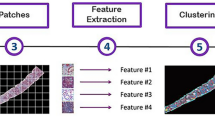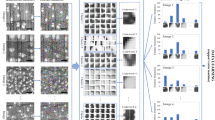Abstract
Urinary Tract Infections (UTIs) are a severe public health problem, accounting for more than eight million visits to health care providers each year. High recurrence rates and increasing antimicrobial resistance among uropathogens threaten to greatly increase the economic burden of these infections. Normally, UTIs are diagnosed by traditional methods, based on cultivation of bacteria on Petri dishes, followed by a visual evaluation by human experts. The need of achieving faster and more accurate results, in order to set a targeted and sudden therapy, motivates the design of an automatic solution in place of the standard procedure. In this paper, we propose an algorithm that combines a “bag–of–words” approach with machine learning techniques to recognize infected plates and provide the automatic classification of the bacterial species. Preliminary experimental results are promising and motivate the introduction of a visual word dictionary with respect to using low level visual features.
Access this chapter
Tax calculation will be finalised at checkout
Purchases are for personal use only
Similar content being viewed by others
Notes
- 1.
Other clustering methods—such as DBSCAN, OPTICS, SOM—have been tested. k–means was chosen since it offers the best trade off between simplicity and performance.
- 2.
For this reason, the training set dimension has been reduced to balance the number of positive and negative patterns (see Table 2).
- 3.
The MLP structures are described in Table 3. Both hidden and output neurons are sigmoidal. Two neurons constitute the ouput layer in order to improve the network flexibility in modeling complicated relationships. All the architectural parameters (for MLPs and SVMs) were chosen via a trial–and–error procedure and crossvalidation.
- 4.
The Weka Class Balancer function has been used to balance the data. This function reweights the instances in the data so that each class has the same total weight. The total sum of weights across all instances will be maintained. Only the weights in the first batch of data received by this filter are changed.
- 5.
Instead, the codebook generation required about 15 min, using a training set of pre–segmented images.
References
National Institute of Diabetes and Digestive and Kidney Diseases, Urinary Tract Infections in Adults. https://www.niddk.nih.gov/health-information/health-topics/urologic-disease/urinary-tract-infections-in-adults/Pages/facts.aspx
Berlin, A., Sorani, M., Sim, I.: A taxonomic description of computer-based clinical decision support systems. J. Biomed. Inform. 39, 656–667 (2006). Elsevier
Deserno, T.M.: Biomedical Image Processing. Springer-Verlag, New York (2011)
Belazzi, R., Diomidous, M., Sarkar, I.N., Takabayashi, K., Ziegler, A., McCray, A.T., Sim, I.: Data analysis, data mining: current issues in biomedical informatics. Methods Inf. Med. 50(6), 536–544 (2011). Schattauer Publishers
Agah, A.: Artificial Intelligence in Healthcare. CRC Press, Boca Raton (2014)
Heckerling, P.S., Canaris, G.J., Flach, S.D., Tape, T.G., Wigton, R.S., Gerber, B.S.: Predictors of urinary tract infection based on artificial neural networks and genetic algorithms. Int. J. Med. Inform. 76(4), 289–296 (2007)
Bianchini, M., Maggini, M., Jain, L.C.: Handbook on Neural Information Processing. Intelligent Systems Reference Library, vol. 49. Springer-Verlag, Heidelberg (2013)
Bandinelli, N., Bianchini, M., Scarselli, F.: Learning long-term dependencies using layered graph neural networks. In: Proceedings of IJCNN-WCCI 2012, pp. 1–8 (2012)
Bourbeau, P.P., Ledeboer, N.A.: Automation in clinical microbiology. J. Clin. Microbiol. 51(6), 1658–1665 (2013)
Andreini, P., Bonechi, S., Bianchini, M., Garzelli, A., Mecocci, A.: Automatic image classification for the urinoculture screaning. Comput. Biol. Med. 70, 12–22 (2016). Elsevier
Andreini, P., Bonechi, S., Bianchini, M., Garzelli, A., Mecocci, A.: ABLE: an automated bacterial load estimator for the urinoculture screening. In: ICPRAM, pp. 573–580. Springer (2016)
Andreini, P., Bonechi, S., Bianchini, M., Mecocci, A., Massa, V.: Automatic image analysis and classification for urinary bacteria infection screening. In: Murino, V., Puppo, E. (eds.) ICIAP 2015. LNCS, vol. 9279, pp. 635–646. Springer, Heidelberg (2015). doi:10.1007/978-3-319-23231-7_57
Andreini, P., Bonechi, S., Bianchini, M., Mecocci, A., Massa, V.: Automatic image classification for the urinoculture screening. In: Neves-Silva, R., Jain, L.C., Howlett, R.J. (eds.) Intelligent Decision Technologies. SIST, vol. 39, pp. 31–42. Springer, Heidelberg (2015). doi:10.1007/978-3-319-19857-6_4
Ferrari, A., Signoroni, A.: Multistage classification for bacterial colonies recognition on solid agar images. In: Proceeding of IEEE IST 2014, pp. 101–106 (2014)
Rousseeuw, P.J.: Silhouettes: a graphical aid to the interpretation and the validation of cluster analysis. J. Comput. Appl. Math. 20, 53–65 (1987)
Calinski, T., Harabasz, J.: A dendrite method for cluster analysis. Commun. Stat. 3(1), 1–27 (1974)
Davies, D.L., Bouldin, D.W.: A cluster separation measure. IEEE Trans. Pattern Anal. Mach. Intell. 1(2), 224–227 (1979)
Tibshirani, R., Walther, G., Hastie, T.: Estimating the number of clusters in a data set via the gap statistic. J. Royal Stat. Soc. Ser. B 63(2), 411–423 (2001)
Aknowledgements
The authors would like to thank Prof. Rossolini and the whole staff of the MV–Lab of the Careggi Hospital for their willingness to provide real data, and for their invaluable experience in interpreting their microbiological meaning.
Author information
Authors and Affiliations
Corresponding author
Editor information
Editors and Affiliations
Rights and permissions
Copyright information
© 2017 Springer International Publishing AG
About this paper
Cite this paper
Andreini, P. et al. (2017). Extraction of High Level Visual Features for the Automatic Recognition of UTIs. In: Petrosino, A., Loia, V., Pedrycz, W. (eds) Fuzzy Logic and Soft Computing Applications. WILF 2016. Lecture Notes in Computer Science(), vol 10147. Springer, Cham. https://doi.org/10.1007/978-3-319-52962-2_22
Download citation
DOI: https://doi.org/10.1007/978-3-319-52962-2_22
Published:
Publisher Name: Springer, Cham
Print ISBN: 978-3-319-52961-5
Online ISBN: 978-3-319-52962-2
eBook Packages: Computer ScienceComputer Science (R0)




